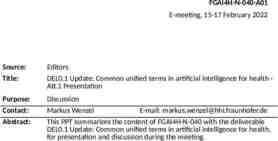Equipment 1
39 Slides3.14 MB
Equipment 1
Learning Objectives At the end of this module, you will be able to: List factors to consider prior to purchasing equipment for the laboratory. Manage the selection and acquisition of new equipment. Describe the requirements for a preventive maintenance program for equipment. Provide a rationale for developing a preventive maintenance programs in your laboratory. Explain how to retire old or outdated equipment. Equipment-Module 3 2
Scenario “The reader fails while performing ELISA / EIA tests. There isn’t a documented procedure for troubleshooting, the maintenance log has not been updated for 2 years, and the manufacturer’s instructions are missing.” What should you do? Why? What should you have done earlier ? What you would do if this happened in your laboratory? Equipment-Module 3 3
The Quality Management System Equipment-Module 3 Organization Personnel Equipment Purchasing & Inventory Process Control Information Management Documents & Records Occurrence Management Assessment Process Improvement Customer Service Facilities & Safety 4
Equipment Management Benefits Test results Variation/ Time Performance high level Lowers repair costs Equipment-Module 3 Lengthens lifespan 5
Equipment Management Benefits Increases safety Reduces interruption of services Greater customer satisfaction Equipment-Module 3 6
Program Considerations Installation Installation Retiring Retiring equipment/ equipment/ disposition disposition Service Service and and repair repair Selection Selection and and acquisition acquisition Calibration/ Calibration/ performance performance evaluation evaluation Maintenance Maintenance TroubleTroubleshooting shooting Equipment-Module 3 7
Equipment Management Overview assign responsibilities for all activities train all personnel on requirements and maintenance needs monitor equipment management activities: ensure all procedures are followed review all records routinely update procedures as needed Equipment-Module 3 8
Selecting and Acquiring Equipment Equipment needs Facility requirements performance characteristics cost reagents Equipment-Module 3 9
Selecting and Acquiring Equipment easy to use language warranty safety will it fit? Equipment-Module 3 10
Acquiring Equipment purchase, lease, rent, donations central acquisition bulk procurement conditions of contract Equipment-Module 3 11
Negotiating Equipment Acquisition Request: wiring diagrams software information parts list operator manual installation by manufacturer trial period Equipment-Module 3 12
Before Equipment Installation confirm vendor’s responsibilities in writing establish checklist Equipment-Module 3 13
Equipment Installation when possible, have manufacturer install and set up do not attempt to use prior to proper installation Equipment-Module 3 14
Equipment Installation verify package contents copy software, if part of system Equipment-Module 3 15
After Equipment Installation Inventory Record Calibration Verification Operating Procedures Maintenance Program Train ALL Operators Equipment-Module 3 16
Equipment Calibration perform initial calibration use calibrators or standards follow manufacturer’s instructions determine frequency of routine calibrations Equipment-Module 3 17
Performance Evaluation Test known samples, analyze data Establish stability for temperaturecontrolled equipment Validate performance with parallel samples Equipment-Module 3 18
Function Checks Monitor instrument parameters: periodically, daily, weekly, monthly after major instrument repair Examples: incubator temperatures wavelength calibration autoclave temperature chart Equipment-Module 3 19
Preventive Maintenance routine cleaning adjustment, replacement of equipment parts Equipment-Module 3 20
Implementing a Maintenance Program assign responsibility develop written policies and procedures maintain records train staff Equipment-Module 3 21
Develop a Maintenance Plan For each piece of equipment establish routine maintenance plan to include: frequency of all maintenance tasks function checks routine replacement of parts Equipment-Module 3 22
Create an Equipment Inventory Log Record: instrument type, model number, serial number location in laboratory date purchased manufacturer and vendor contact information warranty, note expiration date spare parts Equipment-Module 3 23
Spare Parts Inventory Include: record of spare parts log to track stock cost and ordering information Equipment-Module 3 24
Troubleshooting: What is the source of the problem? Sample? Reagent? Water, Electricity? Equipment? Equipment-Module 3 25
When in-house efforts fail: call manufacturer or other technical expert look for options to continue service obtain back-up instrument from central stores or manufacturer refer sample to nearby laboratory Equipment-Module 3 26
Do NOT use equipment that does not function properly WARNING OUT OF ORDER DO NOT USE Equipment-Module 3 27
Service and Repair manufacturers laboratory must schedule routine manufacturer’s maintenance warranty may require repair handled by manufacturer in-house biomedical service technicians Equipment-Module 3 28
Retiring Equipment / Disposal Equipment-Module 3 29
Retiring Equipment / Disposal Equipment-Module 3 30
Documents Develop written procedures for: routine maintenance function checks calibration troubleshooting manufacturer’s service Equipment-Module 3 31
Dedicated Log Book Routine maintenance: calibration service repair by manufacturer all problems Function Equipment-Module 3 checks 32
Recording Problems date problem occurred, equipment removed from service reason for breakdown or failure corrective actions taken date returned to use change in maintenance or in function checks Equipment-Module 3 33
Example of logbook 1 Equipment-Module 3 34
Example of logbook 2 Equipment-Module 3 35
Example of logbook 3 Equipment-Module 3 36
Summary An equipment management program will address: equipment selection preventive maintenance procedures for troubleshooting and repair Documents and records will include: inventory of all laboratory equipment Information provided by the manufacturer on operation, maintenance, and troubleshooting records of all preventive maintenance and repair activities Equipment-Module 3 37
Key Messages A well-organized equipment maintenance program provides: High level of performance and greater confidence in the reliability of results. Fewer interruptions in test performance, lower repair costs, and elimination of premature replacement of equipment. Increased safety for laboratory workers will result from well-maintained equipment. A major part of equipment maintenance is PREVENTIVE maintenance Equipment-Module 3 38
Organization Personnel Questions? Purchasing & Inventory Process Control Documents & Records Occurrence Management Process Improvement Customer Service Equipment-Module 3 Equipment Information Management Comments? Assessment Facilities & Safety 39












































